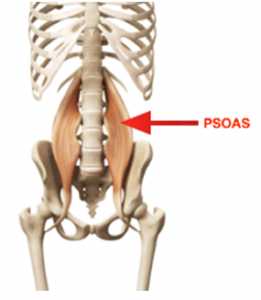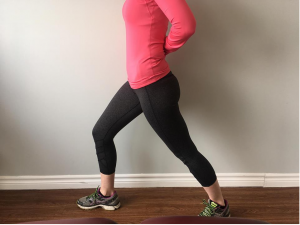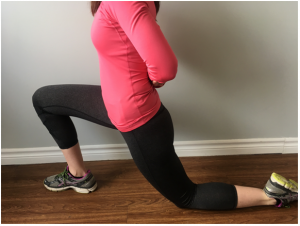
Have you heard about the psoas or hip flexor muscles? Our Oakville Chiropractor has. Do you know where it is, how it can cause trouble, and what you can do to stretch it? With more people working from home than ever, sitting at a computer all day has caused a new pandemic in psoas injuries and anterior pelvic tilt.
Psoas and Hip Flexor Anatomy:
Learn more about the psoas muscle
The PSOAS is a muscle located deep in your lower back. It attaches right onto all five of your lumbar vertebrae and then inserts down onto the inside of your femur (your thigh bone). You have one on both sides of the spine. The muscle is not particularly large, but due to its locatione it can really wreak havoc on the body if it’s too tight or too weak. There are many nerves that run in close proximity to this muscle, or even pierce right through it, and this can cause a whole array of separate symptoms too!
Treatment for Tight Hip Flexors and Psoas Muscle
The most important thing about hip and low back hip pain is the proper diagnosis. Dr. Steve has had patients come into his Oakville clinic with years of low back pain that was really coming from their hip flexors. Others have come in with front sided hip pain, only to waste months of precious treatment time getting diagnostic tests that showed absolutely nothing. If your psoas seems tight to you, or you sit all day at a desk, get in today! The longer you wait, the longer it takes to heal!
How Our Oakville Chiropractor Treats Psoas Pain
At our clinic, the treatment of the hip flexors and psoas muscle is the same for most patients with very slight variations to treatment depending on injury and chronicity of the complaint.
We start with the suction IFC and some heat to loosen the muscles and get the blood flowing. The psoas is a deep thick muscle and the blood flow is key to getting things moving. IFC typically runs for 10-12 minutes, and is a great primer for the rest of the treatment.
Shockwave is a pneumatic gun that breaks up scar tissue/tight muscles and promotes healing. This usually lasts for 90 seconds to 2 minutes and the intensity can be adjusted based upon the patient’s pain tolerance. After the shockwave treatment our chiropractors will move to some Active Release Therapy of the hip flexors. ART is used to further loosen the muscle. This part of treatment is not fun, but trust us when we say the benefits outweigh the 30 seconds of discomfort. Finally, in most patients, due to the fact that the psoas muscle attaches to the front of the low back (spine) patients will get a low back adjustment to free up the joints of the lumbar spine. Patients will go home with icing instructions and stretches. But the biggest thing they must do, is stop sitting at the computer. Get up and move. If this sounds like you book today!
Exercises for Anterior Pelvic Tilt and Psoas Injury:
There are home stretches that are can help reduce some of the muscle tension. When stretching, you should feel the pull in the front of the thigh/groin area. It is important that the stretches are held for 30 seconds, so make sure you give them good long holds. It is ok if the stretch is uncomfortable, but it should not be excruciatingly painful.


How your Oakville Chiropractor Treats a Tight Psoas for Anterior Pelvic Tilt.
So how can the Psoas cause problems? Our Chiropractors find if this muscle is too tight, it can accentuate the curve in the lower back, which alters the mechanics and can increase pain. This accentuated curve is known as an anterior pelvic tilt. Suffering from anterior pelvic tilt in Oakville? We can treat that too!
Here are some chiropractic approved hip flexor and quad stretches!
What Causes Psoas Pain and Anterior Pelvic Tilt?
Your psoas is a hip flexor. For all of us who sit at a desk all day, the psoas muscles are shortened all day. This encourages them to weaken and can also cause spasm when they are forced to lengthen again (ie – when you stand back up). Interestingly, the psoas muscles are also active as you are sitting to help stabilize the spine. Too much sitting = a tired psoas. Athletes are also more susceptible to psoas-related pain. Hockey players are particularly vulnerable due to the flexed posture with skating, and soccer players are vulnerable due to the striking posture of the leg . The back swing lengthens the psoas and can cause it to spasm if it is overstretched. Stomach sleepers who sleep with one leg tucked up also spend significant time with a shortened psoas and getting out of bed can cause pain.
Symptoms of a Tight Hip Flexor
Some frequent symptoms of psoas pain are lower back pain (which can feel quite severe), pain in the front of the hips, pain with coughing or sneezing and difficulty with transitions (for example – sitting to standing or turning over in bed).
Pain from a psoas/hip flexor injury may also be felt in the front of the hip or top of the thigh. Pain may even radiate down into the quad. Pain may be felt with activities like climbing the stairs, lifting the leg and sitting for extended periods of time.
If you think this muscle may be causing some of your pain, come let Dr. Steve or Dr. Jenn sort it out for you!